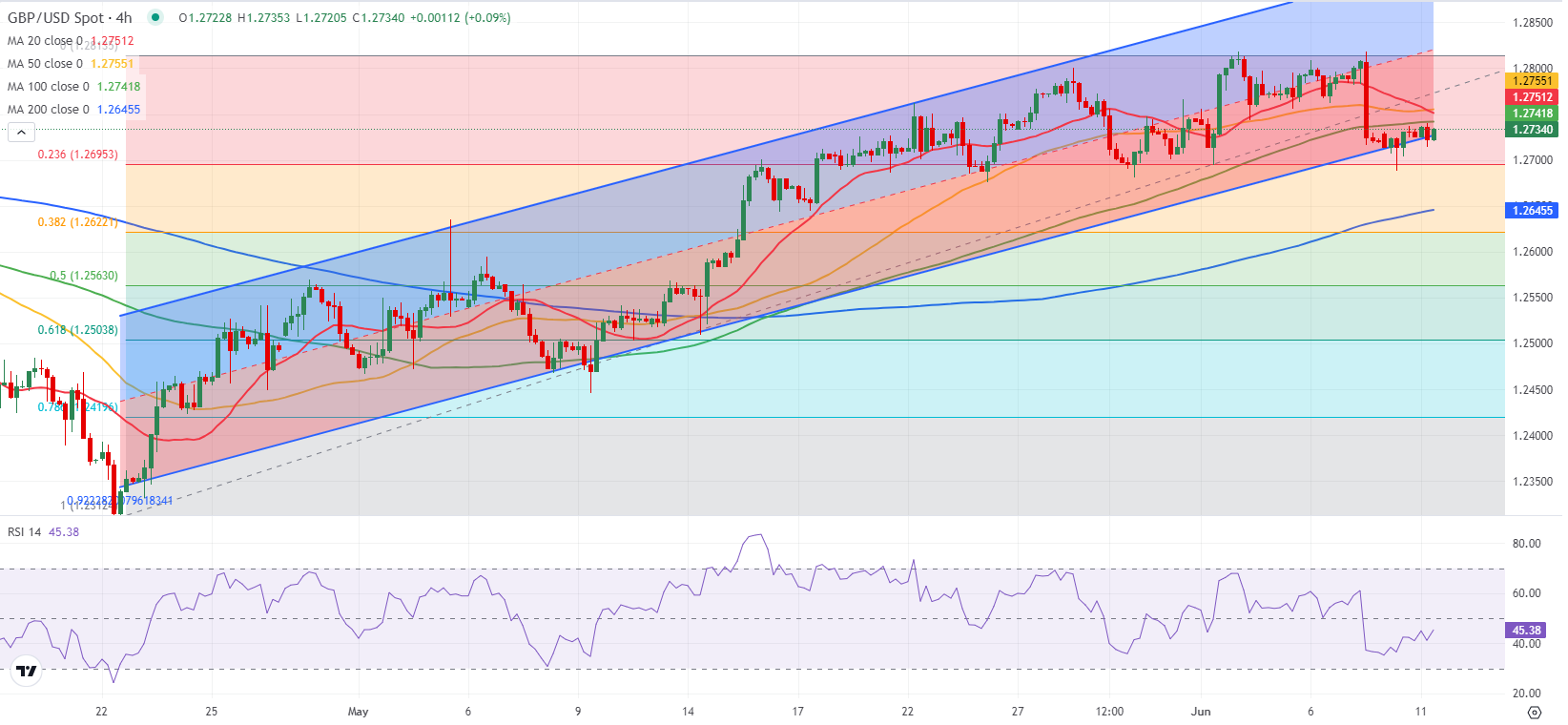- GBP/USD moves sideways above 1.2700 in the European session on Tuesday.
- Mixed labor market data from the UK limits Pound Sterling's upside.
- Market action could turn subdued ahead of Wednesday's key macroeconomic events from the US.
Following a bearish start to the week, GBP/USD staged a rebound and stabilized above 1.2700. The pair's technical outlook doesn't point to a buildup of recovery momentum.
Although the US Dollar (USD) gathered strength on Monday, GBP/USD's losses remained limited. The sharp decline seen in EUR/GBP showed that Pound Sterling was able to capture capital outflows out of the Euro following the European Parliament election.
British Pound PRICE This week
The table below shows the percentage change of British Pound (GBP) against listed major currencies this week. British Pound was the strongest against the Japanese Yen.
| USD | EUR | GBP | JPY | CAD | AUD | NZD | CHF | |
|---|---|---|---|---|---|---|---|---|
| USD | 0.46% | -0.10% | 0.25% | 0.11% | -0.19% | -0.29% | -0.08% | |
| EUR | -0.46% | -0.22% | 0.05% | -0.10% | -0.37% | -0.50% | -0.29% | |
| GBP | 0.10% | 0.22% | 0.40% | 0.12% | -0.15% | -0.28% | -0.07% | |
| JPY | -0.25% | -0.05% | -0.40% | -0.14% | -0.51% | -0.66% | -0.29% | |
| CAD | -0.11% | 0.10% | -0.12% | 0.14% | -0.26% | -0.41% | -0.19% | |
| AUD | 0.19% | 0.37% | 0.15% | 0.51% | 0.26% | -0.13% | 0.08% | |
| NZD | 0.29% | 0.50% | 0.28% | 0.66% | 0.41% | 0.13% | 0.21% | |
| CHF | 0.08% | 0.29% | 0.07% | 0.29% | 0.19% | -0.08% | -0.21% |
The heat map shows percentage changes of major currencies against each other. The base currency is picked from the left column, while the quote currency is picked from the top row. For example, if you pick the British Pound from the left column and move along the horizontal line to the US Dollar, the percentage change displayed in the box will represent GBP (base)/USD (quote).
Early Tuesday, the UK's Office for National Statistics (ONS) reported that the ILO Unemployment Rate edged higher to 4.4% in the three months to April from 4.3%. In the same period, the Employment Change was -140,000. Meanwhile, annual wage inflation, as measured by the change in the Average Earnings Excluding Bonus, held steady at 6% to match the market expectation. Mixed labor market data seems to be making it difficult for GBP/USD to gain traction.
The US economic calendar will not offer any high-impact data releases on Tuesday. In case safe-haven flows dominate the action in financial markets in the American session, the USD could preserve its strength and not allow GBP/USD to stretch higher. Nevertheless, investors could refrain from taking large positions ahead of Wednesday's US inflation data and the Federal Reserve's (Fed) monetary policy announcements.
GBP/USD Technical Analysis
The Fibonacci 23.6% retracement level of the latest uptrend aligns as first support at 1.2700. In case GBP/USD falls below this level and confirms it as resistance, 1.2640 (100-day Simple Moving Average (SMA) and the 200-period SMA on the 4-hour chart) could be seen as next support before 1.2600 (psychological level, static level).
On the upside, immediate resistance is located at 1.2730 (lower limit of the ascending channel, 100-period SMA) ahead of 1.2800 (mid-point of the ascending channel, psychological level, static level).
Pound Sterling FAQs
The Pound Sterling (GBP) is the oldest currency in the world (886 AD) and the official currency of the United Kingdom. It is the fourth most traded unit for foreign exchange (FX) in the world, accounting for 12% of all transactions, averaging $630 billion a day, according to 2022 data. Its key trading pairs are GBP/USD, aka ‘Cable’, which accounts for 11% of FX, GBP/JPY, or the ‘Dragon’ as it is known by traders (3%), and EUR/GBP (2%). The Pound Sterling is issued by the Bank of England (BoE).
The single most important factor influencing the value of the Pound Sterling is monetary policy decided by the Bank of England. The BoE bases its decisions on whether it has achieved its primary goal of “price stability” – a steady inflation rate of around 2%. Its primary tool for achieving this is the adjustment of interest rates. When inflation is too high, the BoE will try to rein it in by raising interest rates, making it more expensive for people and businesses to access credit. This is generally positive for GBP, as higher interest rates make the UK a more attractive place for global investors to park their money. When inflation falls too low it is a sign economic growth is slowing. In this scenario, the BoE will consider lowering interest rates to cheapen credit so businesses will borrow more to invest in growth-generating projects.
Data releases gauge the health of the economy and can impact the value of the Pound Sterling. Indicators such as GDP, Manufacturing and Services PMIs, and employment can all influence the direction of the GBP. A strong economy is good for Sterling. Not only does it attract more foreign investment but it may encourage the BoE to put up interest rates, which will directly strengthen GBP. Otherwise, if economic data is weak, the Pound Sterling is likely to fall.
Another significant data release for the Pound Sterling is the Trade Balance. This indicator measures the difference between what a country earns from its exports and what it spends on imports over a given period. If a country produces highly sought-after exports, its currency will benefit purely from the extra demand created from foreign buyers seeking to purchase these goods. Therefore, a positive net Trade Balance strengthens a currency and vice versa for a negative balance.
Information on these pages contains forward-looking statements that involve risks and uncertainties. Markets and instruments profiled on this page are for informational purposes only and should not in any way come across as a recommendation to buy or sell in these assets. You should do your own thorough research before making any investment decisions. FXStreet does not in any way guarantee that this information is free from mistakes, errors, or material misstatements. It also does not guarantee that this information is of a timely nature. Investing in Open Markets involves a great deal of risk, including the loss of all or a portion of your investment, as well as emotional distress. All risks, losses and costs associated with investing, including total loss of principal, are your responsibility. The views and opinions expressed in this article are those of the authors and do not necessarily reflect the official policy or position of FXStreet nor its advertisers. The author will not be held responsible for information that is found at the end of links posted on this page.
If not otherwise explicitly mentioned in the body of the article, at the time of writing, the author has no position in any stock mentioned in this article and no business relationship with any company mentioned. The author has not received compensation for writing this article, other than from FXStreet.
FXStreet and the author do not provide personalized recommendations. The author makes no representations as to the accuracy, completeness, or suitability of this information. FXStreet and the author will not be liable for any errors, omissions or any losses, injuries or damages arising from this information and its display or use. Errors and omissions excepted.
The author and FXStreet are not registered investment advisors and nothing in this article is intended to be investment advice.
Recommended Content
Editors’ Picks

AUD/USD hangs near multi-year low as traders await US NFP report
AUD/USD consolidates just above its lowest level since October 2022 as traders move to the sidelines ahead of Friday's release of the closely-watched US NFP report. In the meantime, rising bets for an early RBA rate cut, China's economic woes, US-China trade war fears, geopolitical risks and a softer risk tone act as a headwind for the Aussie.

USD/JPY bulls turn cautious near multi-month peak ahead of US NFP
USD/JPY moves little following the release of household spending data from Japan and remains close to a multi-month top amid wavering BoJ rate hike expectations. Furthermore, the recent widening of the US-Japan yield differential, bolstered by the Fed's hawkish shift, undermines the lower-yielding JPY and acts as a tailwind for the currency pair amid a bullish USD.

Gold price consolidates below multi-week top; looks to US NFP for fresh impetus
Gold price enters a bullish consolidation phase below a four-week top touched on Thursday as bulls await the US NFP report before placing fresh bets. In the meantime, geopolitical risks, trade war fears and a weaker risk tone might continue to act as a tailwind for the safe-haven XAU/USD.

Ripple's XRP plunges over 4% following funding rates decline
Ripple's XRP declined 4% on Friday following a decline in its funding rates. The remittance-based token could decline to test the $2.17 support level if the crypto market decline extends.

How to trade NFP, one of the most volatile events Premium
NFP is the acronym for Nonfarm Payrolls, arguably the most important economic data release in the world. The indicator, which provides a comprehensive snapshot of the health of the US labor market, is typically published on the first Friday of each month.

Best Forex Brokers with Low Spreads
VERIFIED Low spreads are crucial for reducing trading costs. Explore top Forex brokers offering competitive spreads and high leverage. Compare options for EUR/USD, GBP/USD, USD/JPY, and Gold.
